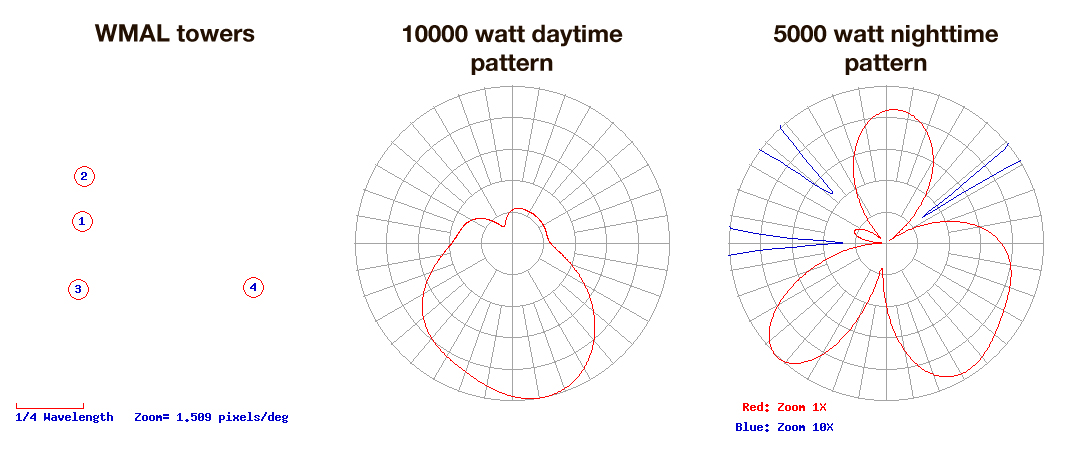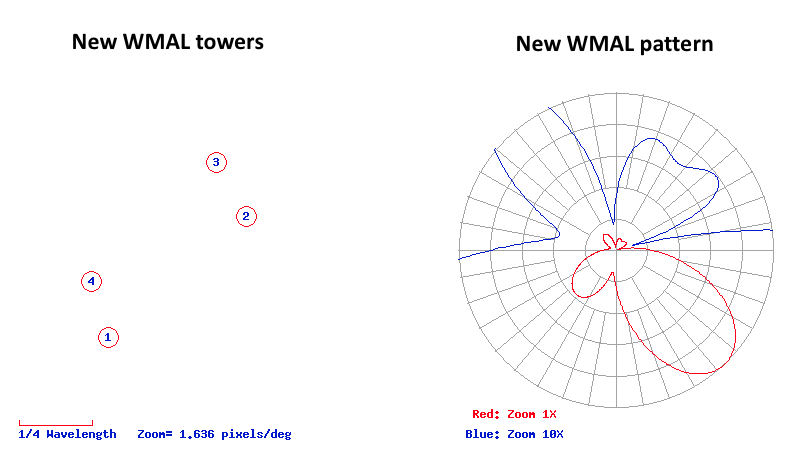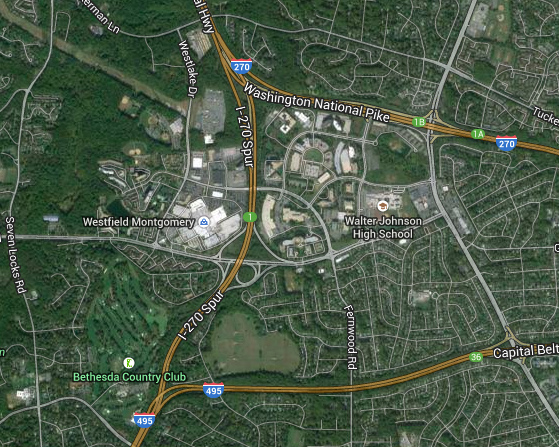This is about AM radio stations being worth less than the ground they stand on. Case in point: WMAL-AM in Washington, DC. You can see the problem with this Google Map:
The heart-shaped patch of green between the legs of I-495 and the I-270 spur is populated by four towers radiating the signal of WMAL, a landmark on Washington’s radio dial (at 630am) since 1925. The station’s 75-acre transmitter site is nearly as big as the nearby Bethesda Country Club golf course and the Westfield Montgomery Mall. It also sits deep in the suburbs, surrounded by trees and highways, most of which appeared long after WMAL erected the towers on cheap open land, far from the bustling Capitol, many decades ago. That land is worth a lot more now.
So it’s no surprise to read news (via The Sentinel) that Cumulus Media, which owns WMAL-AM & FM, has put the land up for sale. Says the report, “Local real estate experts estimate the property could be worth hundreds of millions.” I don’t know what WMAL-AM is worth, but I’m guessing it would be a few million, tops. So it makes financial sense to sell off the land.
But what about the signal? Many AM stations have already “gone dark” (as they say in the business). Will WMAL do the same? In the first comment below, Jon Elbaz, who wrote the Sentinel piece, says Cumulus intends to keep WMAL-AM on the air somehow. But a question is raised: how long can any AM station on desirable land stay on the air? And by what means?
Back in radio’s golden age — when AM ruled the waves — the stations battling for the top of Washington, DC’s ratings heap were WTOP and WMAL. WTOP peaked when it went all-news in the 1960s, and has stayed at the top ever since. It did that by doing great work, and by wisely moving to FM a few years back, taking over the channel (103.5) long occupied by classical WGMS-FM, whose owners by then had unloaded its original 570am signal, which is still on the air as WSPZ. (More about that below.) WMAL also has an FM signal, on 105.9. That one is #9 in Nielsen’s latest figures, while WTOP is #1. WMAL-AM doesn’t show at all.
So I have to wonder about Cumulus’ commitment to keeping the signal on the air. Finding a new transmitter site is not a cheap undertaking. To explain, I’ll need to get technical.
To transmit, AM radio stations require a substantial sum of real estate. AM waves are hundreds of feet long, and require long radiating antennas. These take the form of towers. If a station has a directional signal, more than one tower is required to create the signal’s pattern. WMAL has two different asymmetrical patterns for use in the day and night. Here is how the four towers are arranged, and the patterns they produce:

Each tower is a quarter wavelength high, which at 630am makes them about 400 feet tall. Surrounding them is also a “ground system” of buried conductors running hundreds of feet in all directions from the towers. This is why WMAL needs those 75 acres. To stay on the air, WMAL will need to find replacement acreage, somewhere that allows the signals you see above (or slightly modified versions of them) to cross as much of the Metro area as possible, meaning it will have to be northwest of town. For that Cumulus will need to either buy land out that way, or co-site with some other station already operating there.
The only two stations with transmitters out there are WTEM (“ESPN 980”) and WSPZ, both sports stations (on 980 and 570 respectively) and owned by Red Zebra Broadcasting (in which the main stakeholders are also those of the Washington Redskins). (Here are aerial views, via Bing, of the WTEM and WSPZ sites.)
Of those, WSPZ’s site looks like it has more room. It’s in Germantown, about 22 miles from downtown Washington, more than twice the distance from downtown Washington as WMAL’s current site. I suspect the signal patterns will be “tightened” to concentrate energy toward Washington, though, and that might help. But ground conductivity — which matters hugely for AM signals — is poor in Maryland and Virginia, which is one reason AM stations there tend to suck in the ratings. (For evidence of how much ground conductivity matters, compare three AM stations, all 5,000 watts, and all on 570am: WSPZ in Washington, WNAX in Yankton, South Dakota and KLIF in Dallas. The latter two cover enormous territories, while WSPZ basically covers the District and bits of adjacent Maryland and Virginia. Ground conductivity in the middle of the country is about 15x better than the area served by WSPZ.)
In fact WSPZ is way out of town today because its owners a few years back did exactly what Cumulus is doing with WMAL today: they sold the land out from under the towers. This topo map shows where the WSPZ towers used to be, when it was still WGMS: a site in Potomac, across the Beltway about three miles from WMAL’s site. Believe me, the old signal from the old site covered the metro a helluva lot better than the new signal from the new site. Expect the same results if WMAL moves there.
So again, why keep WMAL-AM on the air at all?
One argument is that the WMAL-FM signal isn’t a great one. While it’s licensed for 28000 watts, it only hits that max to the northwest and southwest of its transmitter in Merrifield, outside the Beltway on the southwest side of town. Toward the district (northeast of the site) its signal has a huge dent, down to around 1/4 of what it puts out in the other directions:
So getting a bit of help on the AM side might still be worth the trouble.
Still, one wonders… How much time will pass before the land under WSPZ becomes far more valuable than the station — or even WSPZ and WMAL put together?
This kind of question sits in front of many AM station owners’ minds right now. I expect what we’ll have in the long run are AM stations standing on land with little or no market value. The rest will disappear along with their real estate.
[Later…] I also wonder about Cumulus’ commitment to saving the signal. In 2011 it acquired (by merger) KAAY/1090am in Little Rock, Arkansas — a 50,000 watt giant with rich history and a night signal that stretches from Cuba to Canada. Or used to. Wikipedia:
Unfortunately, owners of KAAY in later years allowed the stations famed transmission facilities in Wrightsville, AR to fall into disrepair. Copper thieves stole a large amount of transmission line, degrading the stations signal significantly. Roof damage allowed water to enter the 50,000 watt transmitter – knocking it off the air. Currently, KAAY has reestablished 50000 watt service during the day, but has yet to rebuild the 3 tower directional array, so nighttime service remains under an STA at 1250 watts non directional.
KAAY is the biggest AM station in Arkansas. If Cumulus cared, it would restore the station to full capacity. But the format is “brokered/Christian,” which is tends to be low-cost dial-filler. Only one AM station makes the published ratings for Little Rock, and it’s Cumulus’ KARN/920 “The Sports Animal.” Not KAAY. KARN is also at the bottom of the heap. Higher rated are four other Cumulus stations, all FMs.
So the Company isn’t suffering there. Its portfolio of stations does fine, and that’s what matters, right? If the market won’t miss WMAL-AM, why bother keeping it?
[Later again…] This story features an offer sheet on the property, and says offers need to be in by March 12. I also found this older story, about Cumulus’ plan to sell the land under KABC’s transmitter. I can find no evidence that the land has been sold, or is still on the market. KABC also has no construction permits to move to a new location.
[Later again…] Well, apparently they do think it’s worth the bother. Jonathan O’Connell reported this in a February 13 story in The Washington Post:
When the towers are torn down, it will not affect WMAL, said Cumulus spokesman Collin Jones. Jones said the company would lease transmission facilities elsewhere after the sale closed.
“Listeners will literally have no idea that it happened,” Jones said.
Well, some listeners. Others will. There is no way WMAL can move to another site without compromising the signal in some directions.
[May 5…] A buyer for the land has been found, stories in Bethesda Magazine and Radio World report. In a search on FCCInfo.com, however, I see no applications or construction permits at a new site, but perhaps Cumulus is still in negotiations for leasing space at other locations.
[August 2016…] WMAL is indeed moving to the WSPZ site, with 10kw by day and 2.7kw by night. The patterns will be very similar to WSPZ’s. So expect similar coverage.
[June 26, 2018 follow-up] WMAL is now sharing the WSPZ site, and the old towers may already be gone.
Here’s the new tower layout and signal pattern (it’s identical day and night):

Source: FCCinfo.com.
[3 November 2020…] Five years later, the towers will be demolished. See Demolition of Bethesda radio towers will take a piece of history, rare open space, in the November 3 Washington Post.


Leave a Reply